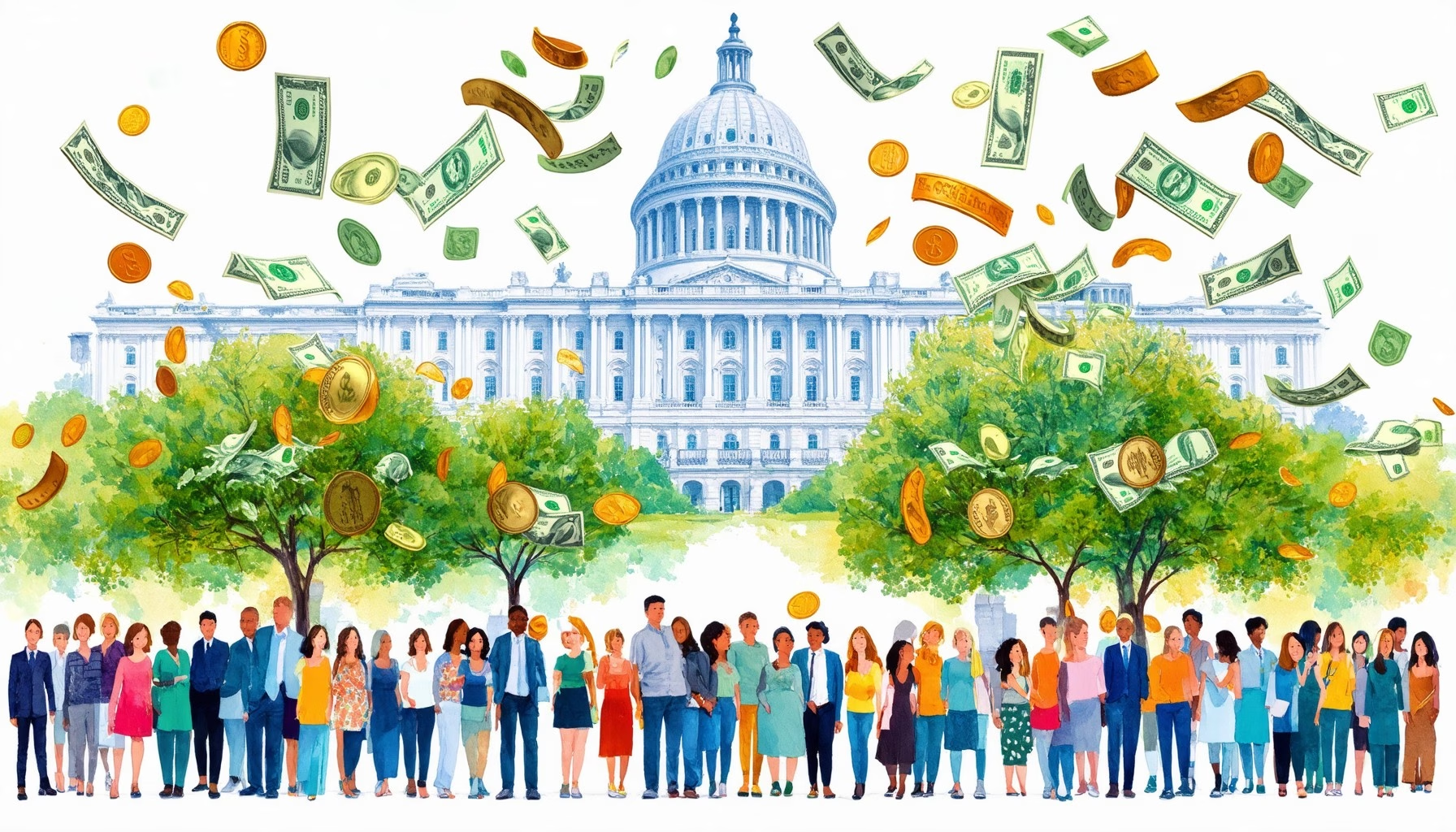Key Takeaways
- Explore various government assistance programs designed to alleviate financial hardships, including TANF, SNAP, and Medicaid.
- Understand eligibility requirements for financial aid, focusing on income levels, residency, and family composition.
- Discover debt relief options through government programs, specifically for federal student loans and tax debts.
- Utilize resources like USAGov to find detailed information on available government benefits.
- Take advantage of first-time home buyer programs that offer grants and low-interest loans to ease the path to homeownership.
- Access free resources and services, such as food assistance, healthcare, and educational support, to enhance your financial stability.
In today’s challenging economic landscape, many individuals and families find themselves seeking the help of the government to navigate financial hardships. This comprehensive guide, titled Navigating the Help of the Government: Discover Financial Aid, Debt Relief, and First-Time Home Buyer Programs, aims to illuminate the various forms of government assistance available to those in need. From understanding the different types of government assistance programs to exploring financial aid options and debt relief programs, this article will provide valuable insights into how you can access the support you deserve. We will also delve into first-time home buyer programs, highlighting the government first-time home buyer grant options that can make your dream of homeownership a reality. Whether you are asking yourself, What is government help called? or How can I get money if I’m struggling?, this article will serve as your essential resource for understanding and accessing the myriad benefits available through government support.
Understanding Government Assistance Programs
Overview of Government Help
Government assistance is commonly referred to as welfare or social support programs. These programs are designed to help individuals and families facing financial hardships. One of the primary forms of government help is the Temporary Assistance for Needy Families (TANF) program, which provides financial aid to low-income families with children. TANF aims to promote self-sufficiency by offering temporary financial support while encouraging recipients to find employment and achieve economic independence.
In addition to TANF, other forms of government assistance include:
- Supplemental Nutrition Assistance Program (SNAP): This program, formerly known as food stamps, helps low-income individuals and families purchase nutritious food.
- Medicaid: A health care program that provides medical assistance to eligible low-income individuals and families.
- Housing Assistance: Programs such as Section 8 provide rental assistance to low-income families, helping them afford safe and decent housing.
- Unemployment Benefits: Financial assistance for individuals who have lost their jobs through no fault of their own, helping them while they search for new employment.
For more detailed information on available government assistance programs, you can visit USAGov, which serves as a comprehensive resource for understanding various forms of aid and eligibility requirements. Additionally, the National Conference of State Legislatures (NCSL) provides insights into state-specific programs and resources that can further assist individuals in need.
Types of Government Assistance Available
Government assistance encompasses a wide range of programs tailored to meet the diverse needs of individuals and families. Here are some key types of assistance available:
- Financial Aid Programs: These include cash assistance programs like TANF and other state-specific financial support initiatives aimed at alleviating poverty.
- Food Assistance: Programs like SNAP ensure that low-income families have access to essential nutrition, helping to combat food insecurity.
- Healthcare Support: Medicaid and the Children’s Health Insurance Program (CHIP) provide vital health coverage for eligible families and children.
- Housing Support: Various government programs, including government programs for first-time home buyers, offer assistance in securing affordable housing.
Understanding these types of government assistance can empower you to seek the help you need. For more information on government programs for first-time home buyers and other financial aid options, explore the resources available at Gov Guider.

Accessing Financial Aid Through Government Programs
If you’re facing financial difficulties, understanding how to access government assistance can be a crucial step toward regaining stability. Government help often comes in various forms, tailored to meet the needs of individuals and families in distress. This section will explore the different types of government cash assistance programs available and how you can determine your eligibility for these vital resources.
Government Cash Assistance Programs
Government cash assistance programs are designed to provide immediate financial relief to individuals and families struggling to make ends meet. These programs can help cover essential expenses such as food, housing, and healthcare. Here are some key government cash assistance programs you may consider:
- Temporary Assistance for Needy Families (TANF): This program offers financial assistance to low-income families with children, helping them meet basic needs.
- Supplemental Nutrition Assistance Program (SNAP): Formerly known as food stamps, SNAP provides funds to purchase food for eligible individuals and families.
- Supplemental Security Income (SSI): This program offers financial support to individuals with disabilities or those who are elderly and have limited income.
- Unemployment Insurance: If you’ve lost your job, this program can provide temporary financial assistance while you search for new employment.
For more detailed information on these programs, you can visit the Official U.S. Government website or explore resources available through U.S. Department of Housing and Urban Development.
Eligibility: Do I Qualify for Any Government Assistance?
Determining your eligibility for government assistance programs is essential to accessing the help you need. Here are some factors that typically influence eligibility:
- Income Level: Most programs have income limits based on household size. You may need to provide documentation of your income to qualify.
- Residency Requirements: Many assistance programs require you to be a resident of the state where you are applying.
- Family Composition: Programs like TANF often consider the number of dependents in your household.
- Employment Status: Some programs may require you to be actively seeking work or participating in job training.
If you’re unsure about your eligibility, I recommend visiting Gov Guider for a comprehensive guide on government programs for first-time home buyers and financial assistance for low-income families. This resource can help clarify the requirements and guide you through the application process.
Exploring Debt Relief Options Offered by the Government
Understanding the various debt relief options available through government programs can be crucial for individuals facing financial difficulties. These programs are designed to assist those who are struggling with specific types of debts, providing a pathway to financial stability. Below, we delve into the key government debt relief programs that can help alleviate financial burdens.
Government Debt Relief Programs Explained
Yes, there are government debt relief programs, but they are primarily targeted at specific types of government-related debts. Here’s a detailed overview:
- Federal Student Loans: The U.S. Department of Education offers various repayment plans, including Income-Driven Repayment (IDR) plans, which can lower monthly payments based on income and family size. Additionally, Public Service Loan Forgiveness (PSLF) is available for borrowers who work in qualifying public service jobs after making 120 qualifying payments.
- Tax Debts: The Internal Revenue Service (IRS) provides options for taxpayers struggling with tax debts, such as Installment Agreements and Offers in Compromise. These programs allow taxpayers to pay off their debts over time or settle for less than the total owed if they meet certain criteria.
- Veterans Affairs: The U.S. Department of Veterans Affairs (VA) offers assistance for veterans with debts related to VA benefits, including options for debt management and financial counseling.
- State-Specific Programs: Some states have their own debt relief programs that may assist residents with specific types of debts, including property tax relief or assistance for low-income individuals.
It is important to note that the federal government does not provide debt relief for non-government debts, such as credit card debts or personal loans. For comprehensive guidance on available programs, individuals can visit official government resources or consult financial advisors.
How to Apply for Debt Relief Assistance
Applying for government debt relief assistance typically involves several steps, which may vary depending on the specific program. Here’s a general outline of the application process:
- Research Available Programs: Start by identifying the specific government debt relief programs that apply to your situation. Resources such as the Official U.S. Government website can provide valuable information.
- Gather Necessary Documentation: Prepare all required documents, including financial statements, tax returns, and any relevant correspondence related to your debts.
- Complete the Application: Follow the instructions for the specific program you are applying for. Ensure that all information is accurate and complete to avoid delays.
- Submit Your Application: Send your application through the designated channels, whether online or via mail, and keep a copy for your records.
- Follow Up: After submission, monitor the status of your application and respond promptly to any requests for additional information.
For more detailed information on federal debt relief options, you can refer to the U.S. Department of Housing and Urban Development and the Consumer Financial Protection Bureau, which provide comprehensive descriptions of available programs and eligibility requirements.
Discovering Free Resources and Benefits
When exploring the help of the government, it’s essential to understand the various free resources and benefits available to individuals and families. These programs can significantly alleviate financial burdens and provide essential support in times of need. Below, we delve into the types of government assistance that can help you access free resources and benefits.
List of Government Benefits Available
Government assistance programs encompass a wide range of benefits designed to support individuals and families. Here are some key programs that you may qualify for:
- Food Assistance Programs:
- Supplemental Nutrition Assistance Program (SNAP): Provides financial assistance for purchasing food, with eligibility based on income and household size. In 2023, the average monthly benefit is approximately $250 per person (USDA).
- Women, Infants, and Children (WIC): Offers nutrition assistance and education for low-income pregnant women, new mothers, and young children, including vouchers for healthy foods.
- Free School Meals: Children from low-income families can receive free or reduced-price meals at school through the National School Lunch Program (NSLP).
- Healthcare Services:
- Medicaid: A program providing health coverage to eligible low-income individuals and families, covering hospital visits and doctor appointments.
- Children’s Health Insurance Program (CHIP): Offers health coverage to children in families with incomes too high for Medicaid but too low for private coverage.
- Housing Assistance:
- Public Housing: Affordable rental housing for low-income families, managed by the U.S. Department of Housing and Urban Development (HUD).
- Housing Choice Voucher Program (Section 8): Assists low-income families in renting privately-owned homes, with vouchers covering a portion of the rent.
- Educational Resources:
- Pell Grants: Federal grants for low-income undergraduate students to help cover college expenses, which do not need to be repaid.
- Free Community College Programs: Some states offer free tuition for community college to residents, reducing the financial burden of higher education.
- Employment and Training Services:
- Job Training Programs: Funded by the Workforce Innovation and Opportunity Act (WIOA), providing training and employment services to job seekers.
- Tax Assistance:
- Earned Income Tax Credit (EITC): A refundable tax credit for low- to moderate-income working individuals and couples, significantly reducing tax liability.
- Legal Assistance:
- Legal Aid Services: Free legal assistance for low-income individuals facing civil legal issues, including housing and public benefits.
$7,000 Government Grant for Individuals: What You Need to Know
One of the most sought-after forms of assistance is the government grant, which can provide substantial financial support without the need for repayment. Here’s what you need to know about the $7,000 government grant for individuals:
- Eligibility: Typically, these grants are aimed at low-income individuals or families, and eligibility criteria may vary based on the specific program.
- Application Process: To apply, you will need to gather necessary documentation, such as proof of income and identification, and submit your application through the appropriate government agency.
- Usage: Funds from these grants can often be used for various purposes, including housing costs, education, and other essential needs.
For more detailed information on available government grants, visit this resource.

Understanding Different Forms of Government Support
Government support, often referred to as government assistance, plays a crucial role in providing financial aid and resources to those in need. This section delves into the various terms synonymous with government support, helping to clarify the types of aid available and their implications for individuals seeking assistance.
Alternative Terms for Government Assistance
A synonym for “government support” is “government assistance.” Other terms that can be used interchangeably include “public aid,” “state aid,” “government funding,” and “subsidy.” These terms encompass various forms of financial or logistical support provided by governmental entities to individuals, organizations, or sectors in need.
- Public Aid: Often refers to welfare programs designed to assist low-income individuals and families.
- State Aid: Typically involves financial assistance provided by state governments to support local initiatives or individuals.
- Government Funding: This term is broad and can apply to various programs, including education, healthcare, and infrastructure.
- Subsidy: Financial assistance aimed at promoting specific industries or activities, such as agriculture or renewable energy.
Understanding these synonyms can help clarify discussions around economic policies and social programs, making it easier to communicate the nature of government involvement in various sectors.
The Importance of Government Support in Times of Need
Government support is vital during challenging times, providing essential resources to individuals facing financial hardships. Programs such as government assistance for housing and grants for disabled home buyers are designed to alleviate the burden of housing costs. Additionally, government programs for first-time home buyers offer financial aid to those looking to purchase their first home, making the dream of homeownership more accessible.
In summary, recognizing the various forms of government support and their significance can empower individuals to seek the assistance they need. Whether through financial aid, housing assistance, or educational funding, government programs are crucial in helping people navigate difficult circumstances.
What are government services called?
Government services are commonly referred to as “public services” or “services of general interest.” These services are essential for the functioning of society and are typically provided by government entities at various levels, including local, state, and federal. The scope of public services encompasses a wide range of sectors, including:
- Judicial Services: Courts and legal assistance that ensure justice and uphold the rule of law.
- Education: Public schools, universities, and vocational training programs that provide access to education for all citizens.
- Healthcare: Public health services, hospitals, and clinics that offer medical care and promote public health initiatives.
- Utilities: Essential services such as electricity, water supply, and waste management that support daily living.
- Emergency Services: Police, fire departments, and emergency medical services that respond to crises and protect public safety.
- Transportation: Public transit systems, roads, and infrastructure that facilitate mobility and connectivity.
- Social Services: Programs that provide assistance to vulnerable populations, including welfare, housing support, and food assistance.
These services are designed to meet the needs of the public and ensure a basic standard of living. According to the European Commission, public services play a crucial role in promoting social cohesion and economic development. For more information on the various types of government services and their impact, you can refer to resources like the Official U.S. Government website and the U.S. Department of Housing and Urban Development.
Overview of Government Services
Government services are vital for maintaining the infrastructure and welfare of society. They encompass a broad range of programs and initiatives aimed at supporting citizens in various aspects of life. From education and healthcare to emergency services and social support, these services are designed to ensure that all individuals have access to essential resources. Understanding the types of government services available can help you navigate the system more effectively and access the assistance you may need.
First Time Home Buyer Government Programs
For those looking to purchase their first home, there are specific first-time home buyer government programs that can provide significant financial assistance. These programs often include grants, low-interest loans, and tax credits designed to make homeownership more accessible. The Federal Housing Administration offers various options that cater to first-time buyers, ensuring that you have the support needed to make informed decisions about your home purchase.
Help from the Government to Buy a House
When considering purchasing a home, many individuals may feel overwhelmed by the financial burden. Fortunately, there are various government programs for first-time home buyers designed to ease this process. These programs can provide financial assistance, making homeownership more accessible for those who may struggle to afford a home on their own.
Government First-Time Home Buyer Grant Options
One of the most beneficial resources available is the government first-time home buyer grant. These grants are typically offered by state and local governments and can cover down payments or closing costs. For example, the U.S. Department of Housing and Urban Development (HUD) provides various programs aimed at assisting first-time buyers. Additionally, the Federal Housing Administration (FHA) offers loans with lower down payment requirements, making it easier for new buyers to enter the housing market.
To qualify for these grants, applicants usually need to meet specific income requirements and may need to complete a homebuyer education course. It’s essential to research local programs, as many states have unique offerings tailored to their residents. For more information on available grants, you can visit the U.S. Department of Housing and Urban Development.
Benefits of Government Programs for First-Time Home Buyers
Utilizing first-time home buyer programs government offers several advantages. Firstly, these programs often provide lower interest rates compared to conventional loans, which can lead to significant savings over the life of the mortgage. Secondly, they may allow for smaller down payments, which can be particularly beneficial for those with limited savings.
Moreover, government assistance can also include tax credits and deductions, further reducing the overall cost of homeownership. By taking advantage of these resources, first-time buyers can navigate the complexities of purchasing a home with greater confidence and financial security. For additional insights on government grants for first-time home buyers, check out our guide on government grants for first-time home buyers.




